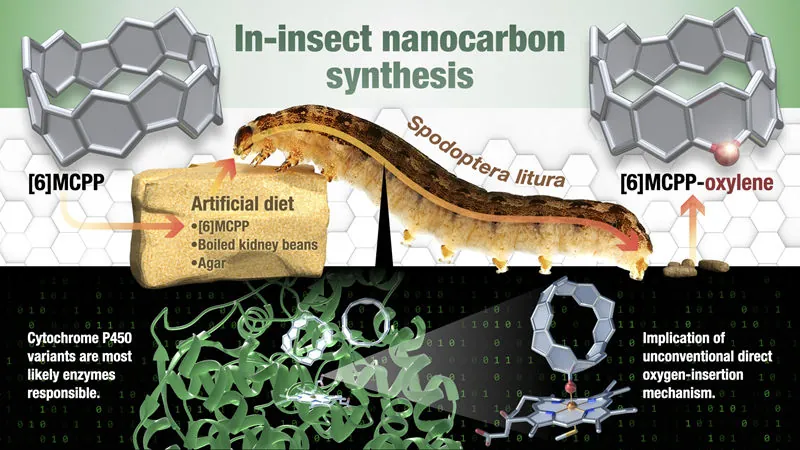
Insects Transformed into Tiny Factories: A Revolutionary Breakthrough in Chemical Engineering!
2025-06-10
Author: Mei
A Groundbreaking Discovery in Molecular Engineering!
Imagine harnessing the power of insects to create state-of-the-art molecules! Researchers at RIKEN have unveiled a fascinating innovation that blurs the lines between nature and technology. They discovered that insects can transform molecular nanocarbons into new, complex substances, paving the way for advanced applications in aerospace, electronics, and more.
What Are Molecular Nanocarbons?
Molecular nanocarbons are incredibly tiny structures composed solely of carbon atoms. Despite their size, they boast strong mechanical properties, electrical conductivity, and even the ability to emit fluorescent light. These characteristics make them prime candidates for revolutionizing lightweight batteries, aerospace components, and cutting-edge electronics. However, the challenge of producing these intricate molecules with the precision needed for practical use has posed a significant hurdle.
From Lab to Life: The Insect Solution!
Enter the innovative idea of using insects! Dr. Itami and his team explored whether feeding molecular nanocarbons to plant-eating insects could spark beneficial chemical reactions. This unconventional approach draws on the insects' evolved systems for digesting foreign compounds, thanks to their unique enzymes that perform complex transformations.
The Bold Experiment!
In an exciting experiment, researchers fed tobacco cutworm caterpillars a diet enriched with a belt-shaped molecular nanocarbon called [6]MCPP. Fast forward two days, and analysis of the caterpillar droppings revealed an unexpected twist: the emergence of a new molecule, [6]MCPP-oxylene, which had gained an oxygen atom, turning it fluorescent!
Unlocking the Chemistry!
By employing advanced techniques such as mass spectrometry and X-ray crystallography, the team mapped the structure of [6]MCPP-oxylene. They pinpointed two specific enzymes, CYP X2 and X3, as the catalysts behind this transformation. Remarkably, computer simulations suggested these enzymes can simultaneously bind with two molecules, executing a rare chemical reaction that scientists have struggled to replicate in traditional labs.
A New Era in Materials Science!
This pioneering study heralds a new era in materials science by shifting from conventional lab methods to utilizing biological systems like insects for molecule production. The implications are staggering—beyond just creating glowing nanocarbons, this could lead to a plethora of innovative applications by bridging organic chemistry with synthetic biology.
Insects: From Pests to Heroes!
Traditionally seen as agricultural villains due to their rapid reproduction and pesticide resistance, the tobacco cutworm now emerges as an unlikely hero in this scientific saga. Through this breakthrough, these notorious pests could play a pivotal role in pushing the boundaries of chemical engineering, showcasing nature's power in sustainable innovation.



 Brasil (PT)
Brasil (PT)
 Canada (EN)
Canada (EN)
 Chile (ES)
Chile (ES)
 Česko (CS)
Česko (CS)
 대한민국 (KO)
대한민국 (KO)
 España (ES)
España (ES)
 France (FR)
France (FR)
 Hong Kong (EN)
Hong Kong (EN)
 Italia (IT)
Italia (IT)
 日本 (JA)
日本 (JA)
 Magyarország (HU)
Magyarország (HU)
 Norge (NO)
Norge (NO)
 Polska (PL)
Polska (PL)
 Schweiz (DE)
Schweiz (DE)
 Singapore (EN)
Singapore (EN)
 Sverige (SV)
Sverige (SV)
 Suomi (FI)
Suomi (FI)
 Türkiye (TR)
Türkiye (TR)
 الإمارات العربية المتحدة (AR)
الإمارات العربية المتحدة (AR)